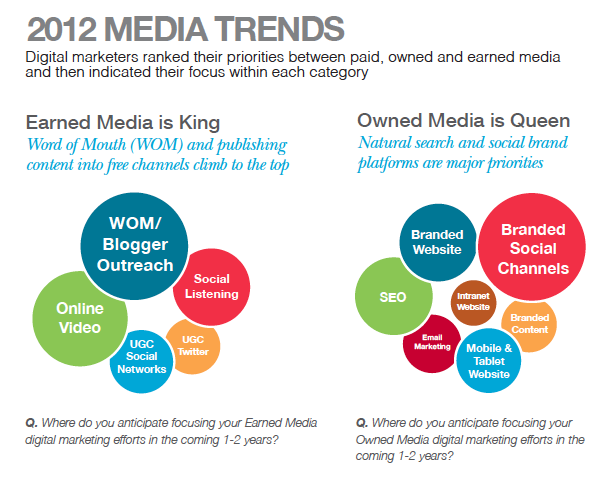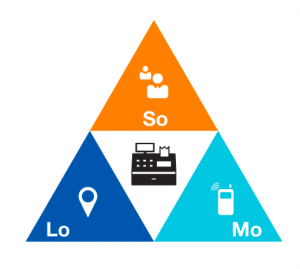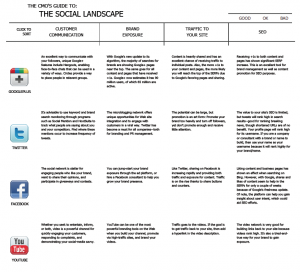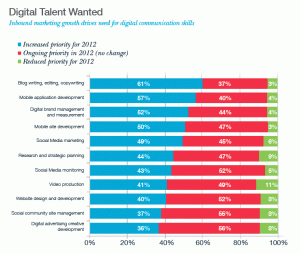December 15, 2011
For the past couple years, I’ve shared the results of the JWT annual year-end forecast of trends for the upcoming year. In the past, we’ve seen predictions for the massive adoption of location based services (2010) and the coming of the Non Commitment Culture (2011) — both of which have come to be.
So I was looking forward to their 2012 report and it did not disappoint. I had a chance to ask Ann Mack, JWT’s Director of Trendspotting a few questions. But before we get to her answers — check out their executive summary. (email subscribers, click here)
Q. Which trend strikes you as the most surprising? That was my first question for Ann Mack as well. Here’s what she had to say:
The trend that surprised me the most was Generation Go. The Millennial Generation has been cast by many in the media as the “Lost Generation,” but this trend turns that notion on its head.
Consider this: In the U.S., 52% of Millennials said they would start their own business if they lose or have trouble finding a job, according to a survey JWT conducted in November, up from 25% in 2009. Nearly 6 in 10 agreed that “My friends are doing interesting entrepreneurial things to make more money,” up from 34% in 2009. This indicates that there’s a solid entrepreneurial streak among Millennials, one that has significantly increased in the past two years.
Twentysomethings in the developed world are finding opportunity in economic adversity. Out of continued joblessness or discontent with the status quo is springing an unprecedented entrepreneurial mindset, enabled by technology that obliterates traditional barriers to entry. A so-called Lost Generation is transforming itself into a uniquely resourceful cohort.
Q. Navigating the new normal seems to be more about re-packaging (less frills University degree, smaller pack of gum, fewer featured tablet like Kindle Fire etc.) than offering something new. How do you think this will manifest itself in the services arena?
You’ll see more services that strip out amenities and features or lower quality standards, DIY options (e.g., Ikea-style assemble-your-own items), off-peak or otherwise restricted offerings, and unbundled/more flexible services and subscriptions.
Equinox gyms, for instance, opened Blink Fitness at the beginning of 2011: The pleasant, polished fitness centers cost just $20 a month (more than $100 less than Equinox gyms in the area), offering the basics and nothing more.
Meanwhile, prepaid, no-contract phone plans—which have been a minimal part of the U.S. mobile market—are now the fastest-growing segment. A new low-cost, no-contract T-Mobile plan offered through Walmart, for example, allows for unlimited Internet access and texting but only 100 voice minutes. The carrier also now offers three Pay by the Day plans, charging customers only for days they use their phones.
Q. How does the trend Reengineering Randomness and the hunger for new/different work in light of both the information overload syndrome and desire to simplify that everyone seems to be dealing with about these days?
To your point, most people welcome the extraction of irrelevant or less interesting information and options. But most people recognize when they are in a rut. Reengineering Randomness is about reaching consumers through surprise and delight, online and off, while avoiding their overstimulation.
As consumers increasingly rely on Hyper-Personalization to help them navigate the Web and the wider world, the random element will come to represent the human touch. Increasingly, breaking through the personalization bubble will become an important way to grab consumers’ attention. By providing a dose of the unexpected, brands can inspire consumers who crave discovery and perhaps find new markets as well.
If you’d like to see the entire 102 page report, you can purchase it here.
More



 It seems like one of the goals I hear more and more is… “and we want it to go viral.” I translate that to mean — we want a lot of people to see it.
It seems like one of the goals I hear more and more is… “and we want it to go viral.” I translate that to mean — we want a lot of people to see it.













